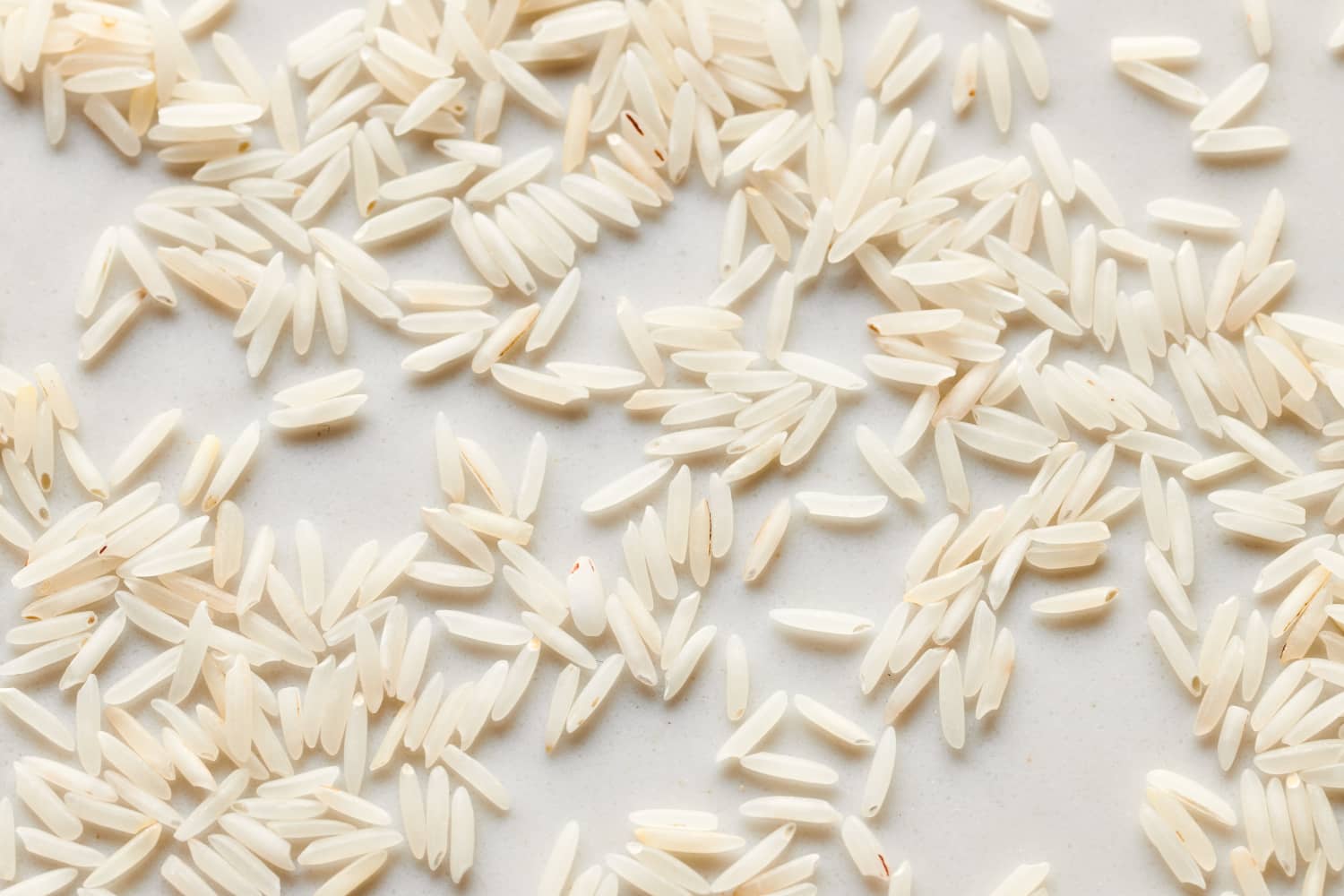Products You May Like

Thanks to its fragrant aroma and fluffy texture, basmati is one of the most popular long-grain rices. Because basmati grains are long and slender, the rice has a fluffy texture with very little stickiness. It’s ideal for eating as a side or as a base for saucy dishes, like curries or red beans and rice. Here’s everything you need to know about buying, cooking, and using basmati rice.
Basmati rice is a type of aromatic long-grain rice that is traditionally grown in northern India and Pakistan in the foothills of the Himalayas. You’ll often see this rice used in Indian and Middle Eastern dishes, including fluffy side-dish pilafs or meat-flecked biryani. It has a toasty fragrance similar to popcorn (thanks to a compound called 2-Acetyl-1-pyrroline) and a light, nutty flavor to match. You’ll find both white and brown basmati rice at most supermarkets; look for rice imported from India or Pakistan for the best flavor.
What Is the Difference Between Basmati and Jasmine Rice?
Even though jasmine and basmati rice are often used interchangeably, there are some differences between these two types of rice. Basmati’s grain are long and more slender; jasmine’s grains are short and rounded. They have a slightly similar flavor, but jasmine rice is a bit more fragrant.
How Should You Cook Basmati Rice?
Stovetop? Oven? A countertop appliance? No matter how you cook basmati rice, we have the best method.
How to Cook Basmati Rice on the Stove
For white basmati rice, measure 2 cups rice into a fine-mesh strainer, and rinse under cool running water for a minute or two. (This will remove excess starch so the rice will be fluffy and separate.) Optional step: For softer rice, place the rice in a large bowl of cold water, and let it soak for 30 minutes to an hour; drain it well. Place drained and rinsed or soaked and drained rice in a large, heavy saucepan with tight-fitting lid and add a pinch of salt. Top the rice with 3 cups boiling water, and bring to a simmer. Cover the pot tightly with foil, crimping around the edges of the pot, and place the lid on top. Reduce the heat to just above the lowest setting and cook for 15 minutes. Remove from heat and let stand (still covered) for 5 minutes. Uncover, fluff, and serve.
For brown basmati rice, use the pasta method: Bring several quarts of water to a boil in a large pot. Measure out whatever amount of rice you’d like to cook, rinse it in a fine-mesh strainer, and add the rice to the boiling water. Cook, uncovered, until grains are tender with a little al dente chew, 30 to 35 minutes. Then drain the rice, add back to the empty pot, cover, and let stand for about 10 minutes before fluffing, seasoning, and serving.
How to Cook Basmati Rice in an Instant Pot
For white basmati rice, measure 2 cups rice into a fine-mesh strainer. Rinse under cool running water until water runs clear. Combine drained rice, 2 cups water, 1/2 teaspoon kosher salt, and 1 tablespoon butter in the pot. Lock the lid in place and set to cook under High pressure for 5 minutes. Allow pressure to naturally release for 10 minutes, then carefully quick release any remaining pressure. Fluff with a fork before serving.
For brown basmati rice, place 1 cup (unrinsed) rice and 1 cup cold water in the pot. Lock the lid in place and set to cook under High pressure for 15 minutes. Allow the pressure to naturally release for 5 minutes, then carefully quick release any remaining pressure. Fluff with a fork before serving.
How to Cook Basmati Rice in a Rice Cooker
For white basmati rice, measure the rice with the cup that came with your rice cooker, then rinse it in a fine-mesh strainer. Add the rinsed, drained rice to the pot, then add salt to taste and water to the level indicated for white rice (rice cookers should have markings inside the pot). If you don’t have a rice cooker cup or markings inside the pot, try a ratio of 1 cup rice to 1 cup water. Set to cook using white rice mode. Let the rice stand in the closed cooker for 10 to 30 minutes after cooking, then fluff and serve.
For brown basmati rice, measure the rice with the cup that came with your rice cooker, then rinse it in a fine-mesh strainer. Add the rinsed, drained rice to the pot, then add salt to taste and water to the level indicated for brown rice (rice cookers should have markings inside the pot). If you don’t have a rice cooker cup or markings inside the pot, try a ratio of 1 cup rice to 1 3/4 cups water. Set to cook using the brown rice mode. Let the rice stand in the closed cooker for 10 to 30 minutes after cooking, then fluff and serve.
How to Bake Basmati Rice in the Oven
For white basmati rice, preheat oven to 375°F with rack in the middle of the oven. Combine 1 cup basmati rice and 1 teaspoon kosher salt in a 2-quart baking dish; add 2 tablespoons butter (it’s fine if it’s cold). Bring 1 1/2 cups water to a boil in a small saucepan or tea kettle. Pour boiling water over rice mixture, stir, and spread the rice into an even layer. Cover the dish tightly with foil, and bake for 25 minutes. Remove from the oven and let the dish rest, still covered, for 5 minutes. Fluff with a fork before serving.
For brown basmati rice, preheat oven to 375°F with rack in middle of the oven. Pour 1 1/2 cups brown basmati rice into an 8×8–inch baking dish, drizzle with 1 tablespoon olive oil or melted butter, and sprinkle with 1 teaspoon salt. Stir until the rice is evenly coated. Bring 2 1/2 cups water to a boil in a small saucepan or tea kettle. Pour boiling water over rice, stir once, and spread rice into an even layer. Cover the dish tightly with foil, and bake for 1 hour. Uncover and fluff with a fork; cover with a clean dish towel (to absorb excess steam) and let stand 5 minutes before serving. As you’ll see with other rice varieties, the towel for resting keeps the brown basmati from getting clumpy.
How to Cook Basmati Rice in a Slow Cooker
This method does not work well with white or brown basmati rice. You’re much better off using one of the other methods. The long, slow cooking process makes these quick-cooking rices gummy instead of fluffy.
How to Store Basmati Rice
Store uncooked white basmati rice in your pantry, either in its original packaging or in an airtight container, such as a Mason jar or tightly lidded plastic container.
Because brown basmati rice still has its bran and germ attached, it contains oils that can go rancid relatively quickly. Be sure to store the rice in an airtight container, such as a Mason jar or tightly lidded plastic container, since exposing the oils to oxygen can start to deteriorate or spoil the grains. An even better option is to store the rice (in its airtight container) in the freezer.
How Long Does Basmati Rice Last?
Our Favorite Basmati Rice Recipes
The nutty flavor and light, fluffy texture of basmati is perfect in these dishes.
